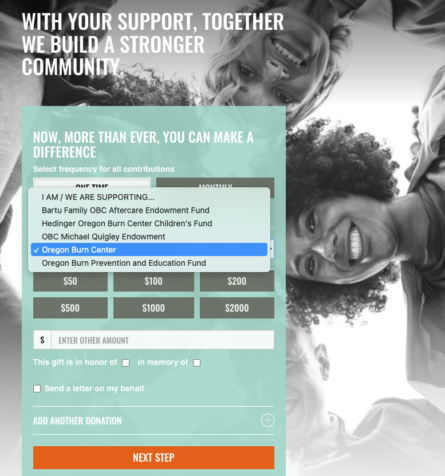5 Things You had No Idea Your Donation Form Could Do

Sometimes a new challenge occurs and needs a creative solution. If your challenge relates to accepting gifts, an online donation form could be the answer.
✔ Donors need the ability to designate funds?
✔ Need a solution immediately?
✔ Moving an existing appeal (maybe a raffle) online?
✔ Trying to increase donor gifts based on past giving?
✔ Want to gather additional donor information while they’re making their gift?
At Legacy Health, I have engineered solutions for our foundations to all of these problems (and more) using online donation forms. Hopefully some of what I have implemented will help your organization!
Full disclosure: I add functionality to our online donation forms, I don’t make them pretty. We worked with a partner on the design and initial coding. As situations came up that required me to creatively engineer a solution or expand the form’s capabilities, I wasn’t afraid to modify their initial work so I could increase the functionality. All the solutions below use our fundraising and marketing software and the initial form created by our partners.
Review the Online Fundraising Checklist for opportunities you can’t afford to miss!
Here are five things you had no idea your online donation forms could do:
1. Offer a choice of funds and/or locations with a drop-down menu.
Legacy Health has multiple sites and foundations with hundreds of funds between them. Many of our donors want to support a specific cause or the hospital where they received care – or a specific cause at a specific hospital. Dynamic designation lists enable us to change how funds and locations are sorted and what is displayed without creating a separate online donation form for every purpose. 
Our dynamic designation lists are based on queries within our fundraising software. The different queries have logic to change the sorting of the list and available designations which are populated into our donation forms utilizing the queries REST API functionality. The public-facing lists are constantly updated in all linked locations. This allows flexibility to quickly add or remove a designation or alter the name or description that is displayed to the donor inside of our donor database and updates are instantly pushed out to all donation forms.
Since all changes to the listed designations and sorting options are based on parameters in the URL, we can quickly generate links to target the desired area of support and our fundraisers are able to easily share these links with donors. With our myriad of donation options we default to only list our most popular designations but the same form is integrated with our designation search functionality. This allows donors the option to enter key words and find their desired support area.
2. Automate raffle ticket and membership sales.
 In 2020, we needed to move our raffle sales online and our existing solutions presented more challenges than solutions. Credit cards were not being charged immediately, processing fees were high, and staff needed to manually assign ticket numbers. I was able to resolve these issues by modifying our existing donation form and utilizing the email acknowledgement capabilities within our fundraising software.
In 2020, we needed to move our raffle sales online and our existing solutions presented more challenges than solutions. Credit cards were not being charged immediately, processing fees were high, and staff needed to manually assign ticket numbers. I was able to resolve these issues by modifying our existing donation form and utilizing the email acknowledgement capabilities within our fundraising software.
The form is set-up like an online donation form, except the form asks for the number of tickets purchased instead of the donation amount and the price per ticket is coded into the donation form. After a ticket is purchased and committed to our database, I run a small SQL script to dynamically assign ticket numbers, which are inserted into the purchase verification email.
3. Increase giving with personalized ask arrays.
This is a great way to use technology to increase donations by meeting donors where they are. Personalized ask arrays use known information about the donor (like giving history) to determine an appropriate ask range.
With a little bit of code I added functionality to our donation form to change the default ask amounts based on a value provided in the URL. This means we use a single donation form with slight changes in the link sent via solicitations to dynamically update amounts supplied to the end user. If your messaging system allows for conditional content this is a great application of that functionality.
Because values are changed based on a parameter in the URL, the methods you use to determine ask amounts of your donors are only limited by the data points available in your database. Instead of dollar values in the ask arrays, you could also use this same functionality to display different gift catalogues (e.g. for $X provide one month of insulin, for $X provide one month of dialysis, etc.).
Forms with smaller donation amounts can be a great entry point for non-donors or for donors with limited resources. Donors of all capacity have gratitude for our organization, and we don’t want to discourage a donor because the ask amount is too high.
Want to grow grateful patient giving? Download The Ultimate Guide to Patient Fundraising.
4. Gather donor interests during a donation.
 The ability to pass additional data via attributes or comments during a donation increases the possibilities of data you can add to an associated constituent record. For example, we added a checkbox to the online donation form asking about interest in planned giving, which enables us to automatically add these individuals to our planned giving communications.
The ability to pass additional data via attributes or comments during a donation increases the possibilities of data you can add to an associated constituent record. For example, we added a checkbox to the online donation form asking about interest in planned giving, which enables us to automatically add these individuals to our planned giving communications.
When that box is checked within the form it sets a value of true to an attribute on the revenue record. This can then be associated with a scheduled global change in our database to automatically add associated mailing preferences to the record ensuring they are included in appropriate future communications.
As a nonprofit we always want to know more about why our donors give and offer them opportunities to engage with our mission, but also recognize there are times when it is not appropriate to prompt a donor for additional information. With a little code you can setup your form to display or hide prompts for more information based on the URL you provide.
5. Quickly pivot for different fundraising needs.
In addition to COVID-19, we experienced wildfires in our state last year which impacted our communities and resulted in some staff being temporarily displaced and some losing their homes. Our amazing colleagues immediately asked how they could help. I found myself on a late evening call as we had people reaching out wanting to donate. I knew we needed to track donations via a specific appeal code and because of previous work I had done, I knew I could create a user-friendly link that would pass both the designation and appeal via the URL and provided that within five minutes of the request.
In this case, there was a very specific response window and we removed barriers to engaging with philanthropy. While that is an extreme example, being able to change appeal codes for donations based on the link is incredibly useful. For example, setting up different links for social media posts to track when engagement converts into donations and which channel is most successful. By only having to change the URL there is minimal staff time goes into supporting these various efforts.
It’s important to me to be able to make an impact within my organization and the best way I can do that is by using the tools and technology we have in place. It’s incredible what you can do when your fundraising and marketing databases talk to each other. And when you’re willing to try something new or take a risk.



